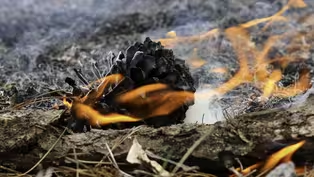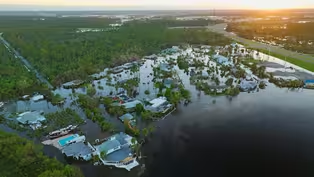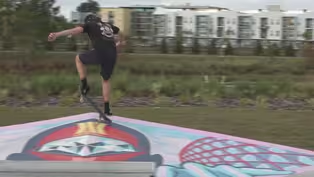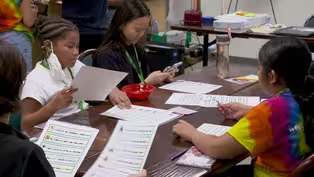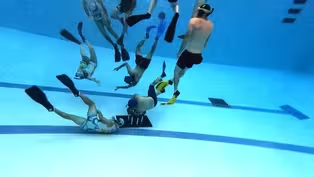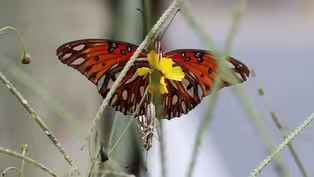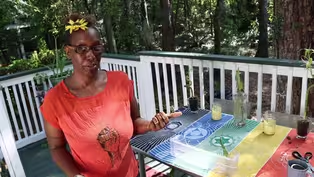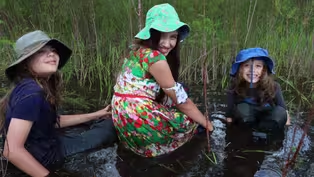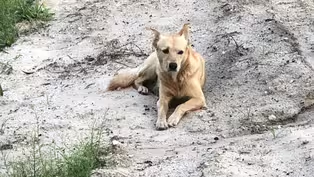
How to Protect Florida Coasts from Hurricane Storm Surge
Clip: Season 8 | 6m 15sVideo has Closed Captions
Researchers combine engineering and ecology to protect coasts from hurricane storm surge.
We visit the University of Miami's SUSTAIN Lab, where an interdisciplinary team of researchers is working to protect coasts from deadly hurricane storm surge. Their approach mixes engineering with natural ecosystems that slow storm surge. They have begun testing the SEAHIVE system, which combines concrete with mangrove trees and corals to create a living coastline that is also armored.
Problems playing video? | Closed Captioning Feedback
Problems playing video? | Closed Captioning Feedback
Local Routes is a local public television program presented by WFSU

How to Protect Florida Coasts from Hurricane Storm Surge
Clip: Season 8 | 6m 15sVideo has Closed Captions
We visit the University of Miami's SUSTAIN Lab, where an interdisciplinary team of researchers is working to protect coasts from deadly hurricane storm surge. Their approach mixes engineering with natural ecosystems that slow storm surge. They have begun testing the SEAHIVE system, which combines concrete with mangrove trees and corals to create a living coastline that is also armored.
Problems playing video? | Closed Captioning Feedback
How to Watch Local Routes
Local Routes is available to stream on pbs.org and the free PBS App, available on iPhone, Apple TV, Android TV, Android smartphones, Amazon Fire TV, Amazon Fire Tablet, Roku, Samsung Smart TV, and Vizio.
Providing Support for PBS.org
Learn Moreabout PBS online sponsorshipDr. Brian Haus: If we don't act, we lose time because that next big impact could come tomorrow.
Or it could come next year.
NARRATOR- Rob Diaz de Villegas: Irma, Michael, Ian.
These Category four and five hurricanes hit Florida within the last five years, as did several smaller storms.
They've destroyed homes and businesses, totaling over $200 billion in damage.
It's not a fluke.
It's a trend.
Strong storms are landing with increasing frequency, and yet our coasts are largely unprotected.
So how can we strengthen coastal communities against wind and waves?
That's what the University of Miami SUSTAIN Lab is trying to figure out, using a state of the art hurricane simulator.
Peisen Tan: So you can customize a hurricane, can create a hurricane, build a hurricane and study specifically what you want.
So this is a computer that controls wave.
NARRATOR- Rob Diaz de Villegas: Soon, Peisen Tan will activate this 1460 horsepower fan to unleash a hurricane within this 38,000 gallon tank.
Peisenn and the rest of the SUSTAIN team are developing solutions that help communities withstand hurricane waves, which on the coast cause more damage than wind.
First, they must understand how waves form and how they transmit energy.
Dr. Brian Haus: If you have a calm surface, and the wind starts to blow, there are some initial perturbations.
The waves starts to form.
Very small waves first.
Peisen Tan: This is a monochromatic wave with a seven centimeter amplitude, which is like a rough wave in the ocean.
Dr. Brian Haus: Over time and distance, the waves continue to grow as the wind pushes on the forming waves.
Peisen Tan: And now I think we're already in a cat one intensity right now.
There are tons of sprays and bubbles all over the water surface.
Dr. Brian Haus: The wind is pushing against that water and adding energy to the water, energy and momentum.
So as that wave continues to propagate and grow, all that wind energy is going into those waves and they can become very large.
NARRATOR- Rob Diaz de Villegas: Because of the weight of water, the larger the wave, the more energy it transmits.
Landolf Rhode-Barbarigos: One cubic foot of water is 64 pounds.
If we take 4 cubic feet of water, it's basically the average weight of an NFL player.
Now, imagine an NFL player running to you and basically tackling you.
Now, imagine a sea of NFL players coming to you and then coming again and again.
Peisen Tan: We’re at a category 5 intensity right now.
The sea sprays are going all the way out.
NARRATOR- Rob Diaz de Villegas: Category five waves may look a mess, but there is an organized wave motion here propelling the weight of water towards our coasts.
Coasts that once looked like this.
This is Saint Vincent Island in the Florida panhandle.
It's a National Wildlife Refuge and a glimpse at what had once been one of Florida's best natural defenses against hurricanes: Barrier Islands.
Dr. Brian Haus: You know, over the pre settlement times in Florida, the barrier islands were natural.
They basically served the function of protecting the mainland from storms and things like that.
NARRATOR- Rob Diaz de Villegas: Florida was further protected by other natural systems.
Landolf Rhode-Barbarigos: Natural systems like salt marshes, seagrasses, oyster reefs, coral reefs, even mangroves- they all kind of protect us, but they all need space and time.
And I argue we don't have that.
NARRATOR- Rob Diaz de Villegas: In much of Florida, these natural systems have been replaced by human structures built directly on the coast.
Miami Beach, for example, is built right on a barrier island.
The SUSTAIN Lab designs barriers to protect those hotels and condos from wave energy.
The challenge is to engineer a barrier that will slow down the waves in the same way natural systems would.
Their designs are tested in a hurricane simulator.
Landolf Rhode-Barbarigos: So what we want to avoid is that that energy transfers by impact into the structures.
Dr. Brian Haus: Traditional construction of things like sea walls.
So a sea wall doesn't take any energy out.
It bounces energy off.
Landolf Rhode-Barbarigos: But sometimes this also worsens the conditions in nearby areas.
Dr. Brian Haus: The key thing for waves is they go into things like salt marshes, oyster reefs, seagrasses, mangroves- they disrupt the motion of the water.
Landolf Rhode-Barbarigos: If we can actually create friction or dissipate the energy by breaking the waves of turbulence and you do it on the right locations when they arrive at the shoreline, you’ll have less impact.
NARRATOR- Rob Diaz de Villegas: To do this, SUSTAIN has developed a hybrid approach that combines engineering with natural systems.
Dr. Brian Haus: The SEAHIVE is a way to replace a traditional sheet pile sea wall with something that is perforated, something that can dissipate more energy locally as opposed to just reflect it, which is what happens at the sea wall.
Landolf Rhode-Barbarigos: The units are hexagonal.
Hexagonal prisms, hollow on the inside, with a series of holes on their side faces.
So what happens there is we pile them up vertically and horizontally.
NARRATOR- Rob Diaz de Villegas: The holes slow down wave energy and can be used as planters for mangroves, marsh grasses and coral reefs which further break up the waves.
Landolf Rhode-Barbarigos:So create kind of like a living shoreline, a hybrid system that we can adapt.
NARRATOR- Rob Diaz de Villegas: SUSTAIN is working towards deploying Sea Hive modules to test sites within the next year.
If they work, they could be strategically deployed more widely over the coming decades, helping to buffer the impact of storms.
In any year, anywhere in Florida, a category five hurricane can hit.
Landolf Rhode-Barbarigos: With all the communities we see more and more, I would say with climate change and rising temperatures, the desertification of the coastlines, I mean, it's almost kind of like the perfect catastrophe scenario for the communities.
So luckily, we have been doing better in terms of preparation, in terms of our codes, in terms of construction.
So whenever we develop something, we want to make sure that this could be used to protect not only the vulnerable regions, but also the vulnerable population.
In the longleaf ecosystem: more fire, more carbon stored?
Video has Closed Captions
Clip: S8 | 6m 42s | How much carbon does a frequently burned longleaf pine ecosystem store? (6m 42s)
How to Protect Florida Coasts from Hurricane Storm Surge
Video has Closed Captions
Clip: S8 | 6m 15s | Researchers combine engineering and ecology to protect coasts from hurricane storm surge. (6m 15s)
Man Battles Glaucoma With Paint and a Positive Attitude
Video has Closed Captions
Clip: S8 | 6m 23s | Meet a septuagenarian who refuses to let Glaucoma get him down. (6m 23s)
Video has Closed Captions
Clip: S8 | 2m 51s | James Cocke discusses having a name that some people like to make fun of. (2m 51s)
Skateboarding at Tallahassee's Skateable Art Park
Video has Closed Captions
Clip: S8 | 4m 17s | The story behind the creation of Tallahassee's newest skate park. (4m 17s)
Not So Black & White|Highlights from Community Conversation
Clip: S8 Ep4 | 2m 26s | Moments from conversation about some of the tough topics raised in NSBW project. (2m 26s)
The Story of Scigirls Summer Camps
Video has Closed Captions
Clip: S8 Ep3 | 5m 9s | We learn about the WFSU Maglab ScigirlsSummer Camp program started in 2006. (5m 9s)
Something Completely Different: Underwater Rugby
Video has Closed Captions
Clip: S8 Ep3 | 7m 16s | It’s like soccer, American football, and snorkeling all wrapped up into a human fishball. (7m 16s)
The Secret to Watching a Gulf Fritillary Life Cycle
Video has Closed Captions
Clip: S8 Ep2 | 2m 54s | Want to See the Gulf Fritillary Life Cycle? Plant Passionflower! (Or watch this video) (2m 54s)
Releasing Dozens of Eastern Indigo Snakes
Video has Closed Captions
Clip: S8 Ep2 | 5m 59s | Twenty-six eastern indigo snakes are released back into the wilds. (5m 59s)
Propagating Joy|Finding Love in Gifts and Discarded Nature
Video has Closed Captions
Clip: S8 Ep2 | 5m 59s | As a study of Black Joy in Green Spaces, artist Chris Omni creates a special project. (5m 59s)
Newly Discovered Species Found Only in Lake Jackson
Video has Closed Captions
Clip: S8 Ep2 | 5m 59s | What is the Crangonyx apalachee and why does it only exist in Lake Jackson? (5m 59s)
Kids Release Striped Newts and Host a Video About It
Video has Closed Captions
Clip: S8 Ep1 | 5m 15s | Two 11-year-olds and one 8 Year old go on an EcoAdventure to release newts (5m 15s)
Video has Closed Captions
Clip: S8 Ep1 | 7m 18s | The rags to riches story of a stray yellow dog. Surf Dog, AKA, Buddy has found a home. (7m 18s)
Providing Support for PBS.org
Learn Moreabout PBS online sponsorshipSupport for PBS provided by:
Local Routes is a local public television program presented by WFSU
